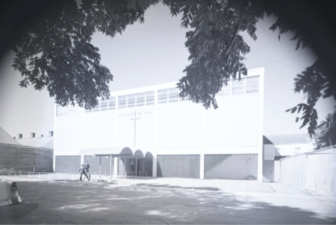Developer Narinder Gupta wants to turn a stark 1956 Curtis & Davis-designed gym at 217 S. Rendon St. into 18 high-rent apartments. The Morris Jeff Community School’s parents want him not to. The neighbors want him not to. City Planning Commission evidently wants him not to – on April 12, at their regular meeting, commissioners unanimously voted down the proposal.
But all of that doesn’t matter, and Gupta will likely get his complex blessed. That’s because Councilmember LaToya Cantrell has it within her power to give him what he wants — regardless of whether it violates the comprehensive zoning ordinance and the much touted Master Plan “with force of law” enacted by voter referendum after Hurricane Katrina.
This is education vs. gentrification — or worse, schoolchildren vs. what may become a complex of short-term rental units offered through Airbnb. And I’m furious about it. I live right behind the building. I pushed for the school to locate in my neighborhood. And the public process, or lack of public process, smells very wrong.
Let me back up.
In 2005, after Hurricane Katrina, the Fisk Howard Elementary School sat in our midst like a drowned dog. Homeless folks camped in it. Young men played soccer on it. The Morris Jeff Community School, in temporary digs on Poydras Street, started talking about making the Fisk Howard site its home.
The Orleans Parish School Board, which owns the site, committed. The City Planning Commission hesitated because the K-7 school would have to fit into a single city block, with limited parking. City Planning Commission staff went around the neighborhood, scoped out available parking, and concluded it could work because of adequate spots on the street.
My neighbors and I went to bat for the school — petitions, a visit to the Morris Jeff board, that sort of thing — and I’m glad we did.
After two years of construction hell, the school opened at its new home in 2015. Every morning now brings a generally good-natured parade of parents and their children walking, biking and driving to school. Even the spectacle of school buses negotiating a 360 degree turn off Rendon to deposit students safely on the school’s side of the street has become part of the neighborhood’s culture. Where there was emptiness, the community has life.
People now move to my neighborhood so their children can walk to Morris Jeff. But charter schools can move anywhere, and tend to do so if they start to feel hemmed in. Gupta’s proposal before the City Council will make it more difficult for Morris Jeff administrators and parents to feel comfortable about keeping their school in this location.
An apartment complex means a lot of occupancy and a lot of coming and going. A 110-unit affordable complex with parking and an onsite manager, built with neighborhood support, already stands at the corner. Parents don’t know how, or if, the new complex would be managed, who would live there, or how they would interact with their children. More cars would force teacher parking off Rendon Street, meaning teachers would have to walk blocks to their cars after work. Cars pulling out of the complex would conflict with the school buses arriving and making that turn. Because the rules governing short-term rentals are very much in question. “Airbnb” and “party palace” keep coming up as concerns.
If Cantrell’s daughter went to this school, I wonder, would we even be having this discussion?
Equally important, Morris Jeff dreams of using the old gym, once operated under the auspices of Sacred Heart, for an early-childhood program that would bring in more Mid-City students. This would mean the gym, which has classrooms on the ground floor, could serve its original purpose as an accessory space for a school. It would also mean possible restoration of the building, a classic in the mid-century modern architectural style. If the proposal to turn the gym into condos gets City Council approval, that opportunity will disappear forever.
It’s not up to the City Council to tell a property owner what to do, but the new CZO lays out conditions for reusing old buildings that this project absolutely doesn’t meet. A good redevelopment of an old building, it suggests, should do no harm to the building or the neighborhood. This proposal hurts the school by taking out parking and adding density and traffic, and what hurts the school hurts the neighborhood.
The process of public review and approval, meanwhile, has been all but scoffed at by the developer, whose behavior suggests that he knew all along what the outcome would be. At City Planning, he submitted an application whose elevations didn’t show windows. Additional windows would be a brutal violation of the building’s historic character but are a building-code requirement if the gym is turned into an apartment complex.
Gupta requested a deferral after Planning Commission staff pretty much panned his proposal. He then failed to show up at the commission’s April 12 meeting. Even novices know that a request for deferral doesn’t insure deferral. My neighbors were there, the commissioners were there and deferral was declined. The project was then moved to a vote and unanimously defeated.
This sent the proposal into the no-man’s land between City Planning and the City Council — where rules for public engagement and review are next to non-existent. Neighbors started asking to meet with Cantrell in early May, when the Council posted notice that the proposal was coming their way. On May 31, Cantrell “circled back” (her words) about holding such a meeting; it was scheduled for June 9.
The Mid-City Neighborhood Organization voted to ask the Council to send it back to City Planning, then voted to oppose the proposal altogether.
On June 1, eight days before the scheduled June 9 Council hearing on the development, Gupta’s team filed new plans with City Planning and emailed them to neighbors. The refiled plans now showed windows galore.
We won this round: parents, residents, neighbors. But we know it’s coming back again, bigger and badder than ever.
At a hastily organized meeting on June 3, 15 residents, a representative of the Mid-City Neighborhood Organization, and a representative of the Morris Jeff Parents Organization met with Cantrell and again voiced their opposition to the apartment proposal. (We’ve been voicing this opposition since Gupta bought the property from the Catholic Church in 2013, which, incidentally, may be the last time the grounds were mowed.) The meeting, ironically, was held at Morris Jeff, the school the project endangers.
Cantrell made excuses for Gupta’s non-appearance at City Planning. Asked why she backed this proposal, she became angry. “This city is facing a housing crisis. That’s a fact,” she insisted. (Fact: There is an affordable-housing crisis in New Orleans, not a luxury-apartment crisis.)
The 1956 gymnasium qualified as a historic structure, she insisted, even though the new plans now showed windows chopping up its exterior facade. She said that she hadn’t made up her mind; what we heard was that it is a done deal.
“Why won’t you listen to the community?” one resident asked.
Cantrell looked around the table. We were white, black, grey, straight, gay, parents and not. “You’re not the community,” she said.
“Maybe the developer’s the community,” mumbled a neighbor as we exited in the rain.
Just this week, I received word that the State Historic Preservation Office has in fact certified the building as a contributing historic structure. Their review praised the old gym building for its “strikingly simple” design, and went on to state, “The building is notable for its lack of windows. There are no windows at all on the front elevation and very few on the sides.” At the same time, the office confirmed that they have not received or reviewed the new, windowed plans for the project, which would pretty much negate everything they thought made the old gym special.
The input by the state preservation office provides a basis for pushing this development through, on the argument that the gym is historic and an important neighborhood building. But the plans that are currently on the table will turn this simple, modernist cube into something else, something that’s not historic — and also notably ugly. The jury’s out on whether state preservation officials will go along with those plans or approve them for historic tax credits that can be used to fund the renovation. This project might be going nowhere after all.
Contacted Wednesday, Cantrell was outraged at the notion that she had been pulling for the developer. “How can you say that I haven’t listened to residents when I actually agree that what is being proposed is not a good fit for the neighborhood?” she asked. She stressed again that she hadn’t made up her mind, but added that her office didn’t control the process that had put the proposal on the Council agenda. “That building will come back into commerce – it has to,” she said. “But this is not a one-way deal – it’s going to take balance on all sides.”
An hour after that conversation, word came from other Council members’ offices that ZD 36/16 was being withdrawn from the Council docket for June 9. In a statement issued later that afternoon, Cantrell again spoke up for the developer, saying that he was not to blame for the “limited timeframe for changes” after the project was defeated at City Planning. She also lamented that Gupta had somehow drawn suspicion for “trying to create a less dense project more in line with the wants of the neighbors.”
I’m still scratching my head over this one. Reducing the number of bedrooms from 46 to 33 in the run-up to the City Council hearing gave him a double bonus: by reducing his “unit count” to 18, he could pitch his plan with fewer parking places (only one place per unit is required) and also avoid the need for additional density waivers if the project were deemed an adaptive reuse of a historic institutional building. I thought it was a pretty clever tactic, myself.
As for who was to blame for the shorter timeline: I think that anyone who applies to City Planning Commission with plans as baldly deficient as the ones Gupta sent bears the blame for any subsequent delay.
The school’s concerns in one area – traffic patterns around the school — are now being addressed actively by Cantrell, and that’s a direct, positive outcome of this dustup. But there’s nothing in the results to suggest that new, dense, luxury apartments next to the school are off the table.

We won this round: parents, residents, neighbors. But we know it’s coming back again, bigger and badder than ever. Cantrell closed her note with a hint that the developer might now move to demolish the gym. And because the Master Plan “with force of law” is only a theory when matters reach City Council, that could clear the way for – anything.
To be continued.



